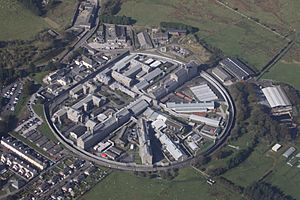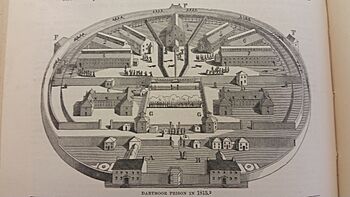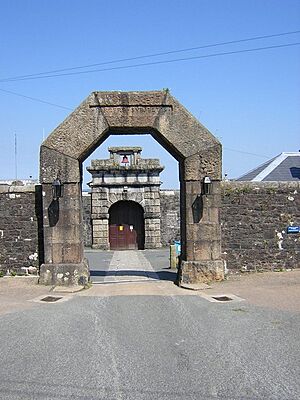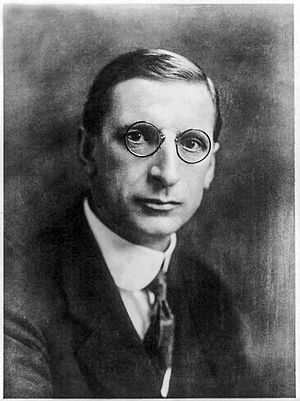HM Prison Dartmoor facts for kids
 |
|
| Location | Princetown, Devon |
|---|---|
| Coordinates | 50°32′59″N 3°59′46″W / 50.54972°N 3.99611°W |
| Security class | Adult Male/Category C |
| Population | 640 (as of January 2016) |
| Opened | 1809 |
| Closed | 2024 (temporarily) |
| Managed by | HM Prison Services |
| Governor | Steve Mead |
| Website | Dartmoor at justice.gov.uk |
HM Prison Dartmoor is a men's prison located in the village of Princetown, on the high, windy plains of Dartmoor in Devon, England. Its tall walls are made of granite, a type of stone found in the area. The prison is owned by the Duchy of Cornwall and run by His Majesty's Prison Service.
It is a Category C prison. This means it holds prisoners who are not considered a high risk to the public.
In 1987, Dartmoor Prison was made a Grade II listed building. This means it is a historically important building that must be protected. The prison closed for a short time in 2024 to fix a problem with a natural gas called radon.
Contents
The History of Dartmoor Prison
A Place for Prisoners of War
In the early 1800s, Britain was at war with France in the Napoleonic Wars. Many French soldiers were captured and held on old, crowded ships. The conditions on these ships were very poor, and there were fears the prisoners might escape.
To solve this problem, the British government decided to build a special prison in a remote place. They chose Dartmoor because it was far away from any large towns. Construction began in 1806 and finished in 1809. The first prisoners to arrive were French soldiers.
Later, during the War of 1812 between Britain and the United States, about 6,500 American sailors were held at Dartmoor. The food was not good and the buildings were leaky. Inside the prison, the American prisoners created their own community. They had their own leaders, a market, and even a theatre.
Escapes and a Sad Event
Escaping from Dartmoor was extremely difficult. The prison had high stone walls, and guards were always on watch. A rope with bells was tied around the prison to sound an alarm if anyone tried to get out. Even if a prisoner got past the walls, they would have to cross miles of wild, foggy moorland to reach safety. Still, a few American prisoners managed to escape.
A sad event happened on April 6, 1815. The War of 1812 had ended, but the American prisoners were still waiting for ships to take them home. They grew impatient and started to protest. The prison's commander, Captain Shortland, thought they were planning a mass escape.
When some prisoners broke a gate chain, the guards were ordered to fire their guns. At first, they fired over the prisoners' heads. But when the crowd threw stones, the soldiers fired directly at them. Seven prisoners were killed and about 60 were wounded. This event became known as the "Dartmoor Massacre." A memorial was later built for the 271 American prisoners who died at Dartmoor and are buried there.
Closing and Reopening
After the wars ended, all the prisoners were sent home. The prison was closed and left empty for 35 years. In 1850, it was rebuilt and reopened as a prison for British criminals.
During the First World War, the prison was used for a different purpose. It became a work center for conscientious objectors. These were people who refused to fight in the war for moral or religious reasons. They were allowed to wear their own clothes and could even visit the local village.
The 1932 Riot
In 1920, Dartmoor once again became a prison for regular criminals. It gained a reputation for being a tough place. The difficult conditions led to a major riot on January 24, 1932.
The prisoners were unhappy with the quality of their food. One day, about 50 prisoners refused to follow orders. The other prisoners were marched back to their cells but would not go inside. The prison staff had to retreat to a safe part of the building. The prisoners caused a lot of damage, but no staff members were hurt. Eventually, more guards arrived and the riot was stopped.
Famous People at Dartmoor
Over the years, many well-known people were held at Dartmoor. One of the most famous was Éamon de Valera. He was an important Irish political leader who later became the President of Ireland. He was held at Dartmoor in 1919 for his role in the fight for Irish independence.
Dartmoor Prison Today
Dartmoor is a very old prison, and keeping it in good condition is a challenge. In the early 2000s, reports criticized its poor sanitation and overcrowding. Since then, many improvements have been made.
Today, Dartmoor is a Category C prison. It holds offenders who have committed less serious crimes. The prison offers education and job training to help prisoners prepare for life after their release. They can learn skills like brickwork, carpentry, and electronics.
The Dartmoor Jailbreak
A fun charity event called the "Dartmoor Jailbreak" happens every year. Members of the public pretend to "escape" from the prison. They have four days to travel as far as they can without paying for transportation. The event raises money for good causes.
Future of the Prison
For a while, it seemed like the prison might close for good. But in 2021, it was announced that Dartmoor would remain open.
In 2024, all the prisoners were moved to other prisons. This was because high levels of a natural gas called radon were found in the building. Radon comes from the rock deep in the ground. The prison closed so that the building could be made safe. In 2025, some former inmates and staff planned to take legal action, saying the radon had affected their health.
Dartmoor Prison Museum
The Dartmoor Prison Museum is located in the old dairy buildings next to the prison. It tells the story of the prison's long history.
Visitors can see exhibits about the prisoners of war from the Napoleonic Wars and the War of 1812. There are also displays of old uniforms, tools, and other items from the prison's past. The museum shows how the prison has changed over more than 200 years. The museum stayed open even when the prison closed for repairs in 2024.





